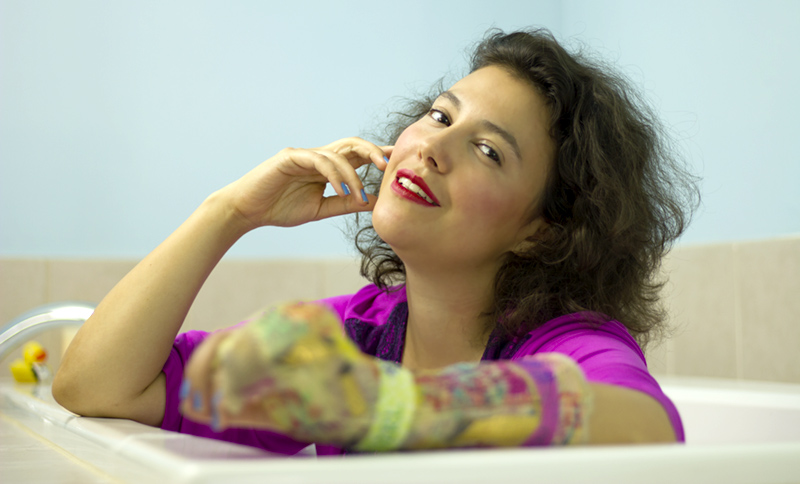How does one decide to make performance art? Where does it come from? And at what point does one say “how about I do this in a bathtub?” In a TheatreBloom exclusive interview with performance artist Siobhan O’Loughlin, currently performing her Broken Bone Bathtub right here in Charm City through Submersive Productions, we sit down and talk one on one about how the world-renowned bathtub show got its start and where it’s going next.
Thank you for taking your time to sit down with us today! If you’d give us just a brief introduction we can get going and I’m sure the readers are anxious to learn all about this bathtub show!
Siobhan O’Loughlin: My name is Siobhan O’Loughlin, I’m from Salisbury, Maryland but I’ve been residing in New York City for the last seven years, that’s been my home base since I graduated from Towson. In the past year, well 2016 started with the bathtub in New York City. I just counted the other day— I went through my google calendar realizing I had never taken a toll— I have now taken 179 bubble baths for this show. I think when I hit 200 or 250 I need to make a sign or do something to celebrate. People ask me all the time how many baths have I taken and I’ve always said I had no idea. I just sort of live this life. I live in a tub. So then I decided to count. By the time I finish with this run here in Baltimore I will have taken 194 baths. That’s pretty cool.
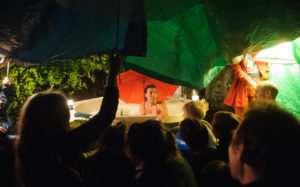
New York City, I went from there to Australia where I performed in Canberra and Sydney. It was an interesting experience, two different neighborhoods in Sydney. And for one of them this whole house piece was curated. There was a durational piece happening outside of the bathroom with a woman in the kitchen and then in the living room space there was a film and audio thing going on where you could participate. I loved Sydney. After I left there I went to Ireland where I performed at the Cathedral Quarter Arts Festival in Belfast. I had a great team that I worked with out there. It was two guys with this company called Shot Glass Theatre. Their thing is doing theatre but in a pub. So with me they were doing theatre but in a tub. They were hilarious and wonderful. We did a bunch of performances at that festival.
Then I went to Orlando where I went to Orlando Fringe, which was my only Fringe Festival this year, and probably my final Fringe festival of my life? I’m not sure. I think for me that’s what I need to do. I have to have different targets. Fringe is a great place to establish and launch or springboard from. I’m 28 now and Fringe Festivals have helped me a lot through my 20’s to travel and get exposure in places. I’ve told myself that if something really strikes me this year— I’ll be 29 in October— like Edinburgh Fringe Festival, I’ll go for it, but otherwise I think the Fringe Festival phase of my life is complete. From Orlando I went to St. Louis where I was performing in a mansion for a month. It was very cool. Then I took a hiatus from performing to go volunteer at the refugee camps in Greece. After Greece I came to Baltimore. Those have been my travels this year.
Where does the bathtub go after leaving Charm City?
Siobhan: After I leave Baltimore I’m actually going back to New York because Broken Bone Bathtub has three New York Innovative Theatre Award nominations. It’s up for best script, best solo performance, and best performance art production. That’s very exciting. After New York, I’m going to be in the Philippines for seven weeks. I have a grant to write a new play with a Filipino artist out there. I’m hoping to do a bathtub show while I’m there. I’ve thought about getting a blow-up bathtub to make it happen. I’m hoping I can round out 2016 at an even 195 bubble baths by doing a show in the Philippines. That takes me all the way through mid-November and then there’s a nice little break over the holidays. I start up baths again in New York on January 12, 2017.
Do you have a resident space where you perform when you’re in New York City?
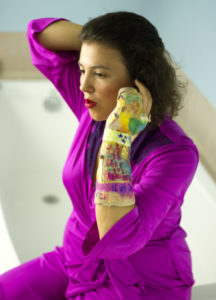
Siobhan: I had a theatre company that produced me last time. That was great. They have other things that they want to work on and do, and they were not the perfect fit the way it is with me and Submersive here in Baltimore. They didn’t want to necessarily keep going with the bubble baths after producing 50 of them. And I completely understand that. But because of them, we got a ton of press. We got a mention in the New York Times! People really wanted to go and experience the show but it just didn’t work out for them. So what I’ve done is I’ve asked for the help of some other immersive theatre artists to get me a team going. Now I have a team of people that I’ve actually hired to produce the show and make it happen. It’s really cool because I’m running it, but I have an amazing Production Manager who’s a really good hustler and has our timeline all laid out. We’ll be visiting all the boroughs in the city. I take a bath in every neighborhood of New York City.
The idea is that if you live out in the Bronx you might not have to travel into Manhattan to see a show. You can go and see one right there in your neighborhood. This is a nice aspect of what home theatre does. It doesn’t have to be an exclusive event; it can actually be a really accessible event. You can walk to it, you can meet people in your neighborhood. It’s special but it’s not something that you don’t have access to. That’s very much the vibe that we want to have going in New York for the months to come.
Are you planned out beyond New York or will you just play it by ear?
Siobhan: In May I’m in Chicago for the very first time with the bath! I’ll be working with a modern dance company. They told me I was on their radar and had expressed an interest in doing it before someone else out there did it. They are cool friends of mine and Fringe Artists who are just amazing modern performance makers. We’ll be doing a spring launch of the bathtub out there, though we’re not sure exactly how that’s going to manifest just yet.
What have been the challenges of adapting this show to all of these different venues and the different cities? You aren’t bringing a bathtub with you on your back, so what’s it like having to curtail your show for specific locations?
Siobhan: Can I talk about the advantages first? It’s an extremely producible show. We’re not paying for a space, we’re not paying for lighting or sound, we’re not paying for all of the different technical elements that come with working in a traditional space. Or even that come with taking a traditional show on the road. It’s really great because with this show you don’t need all of those things. It means that it’s extremely travelable. Do you know anyone anywhere that has a bathtub and would like to host this show? Like with Sydney, I had a few friends there that I had asked there, “do you know anyone who would be able to produce my show?” My friend Emma McManus, she’s amazing. And she knew some people who were interested in hosting me.
Mostly we go for homes. It’s finding people who are down with opening up their home. We want them to have the general attitude of “Hey, I’d love to open up my house and have some cool-ass people inside and have a performance happening where I don’t even have to leave my home for the night.” I had a really good friend in Brooklyn who is a mom. She and her husband were like, “Cool. We don’t have to pay for a babysitter. We can put our kids to sleep and we can watch a performance, have cool people in our house, have wine, and have this lovely event.” That’s something that certain people really enjoy. Now, other people are definitely the opposite. “What? Strangers in my house?” And they think it’s weird, so we just look for the people that don’t think it’s weird.
So how has the show changed through your travels?
Siobhan: Well, like with Orlando? That was the first time I had ever performed in a hotel room. I had to pay for it. Financially it didn’t work out. We got a handicapped accessible room, which was great because it meant that people in wheelchairs could attend the performance but it also meant that there was more space for bodies. We made it an audience of ten, but it was a very tight ten. The Fringe Festival kicked in a little bit of money, but overall I’ve discovered that having to essentially rent out the hotel room for the nights I was doing the festival didn’t work out. That was sort of the problem with mansion in St. Louis, they took a large cut of the ticket sales. As an artist where this is my livelihood, I’ve learned that things like that just don’t work for me. I need to make money to keep producing this show. I want to share all the money and share all the wealth, but I can’t. The reason that this show is site-specific was to cut out the cost of paying for a space. I do perform other shows where I pay for stage space. And while I love the artist community of Orlando and St. Louis, I’ve discovered that working out of homes is just a better fit for me and the show.
That’s actually the challenge. It’s one of the biggest challenges for me because it determines where I can book. It also determines my overall financial situation for the project. It’s hard when you’re approached by production companies, which at this point have all been Indie companies, but with this? The play is my idea, it’s my concept, it’s my performance, it’s everything. So I have to make a certain livable wage to keep it up and going. I want everyone to get paid. I wish I could pay everyone thousands of dollars. But the truth is when your capacity is limited like it is for this show? I mean twelve, which is the number that we can have in the audience here in Baltimore? That’s a huge number. We’re actually at the point where we cannot fit 13. That’s just too many people. And those are sort of the depressing challenges, figuring out how limited your space is, how much money you might make out of certain venues verses others.
Are there more fun or positive challenges associated with the show?
Siobhan: The positive and fun challenge is being able to really throw yourself for it. In some of these venues I get there and have no idea what I’m walking into. I’m just going to show up, take a look at the bathroom and go from there. That might mean that I have to sit to the side because of the shape of the bathtub. I might find myself performing in profile because I’m trying to keep my stuff underwater. Maybe the bathtub bar is kind of low and my boobs need to be adjusted to stay covered. And then of course, thinking about how to arrange the audience in the space and what configuration will work best for them. That’s been really exciting and really fun. I’ve always found it to be really fruitful and something that I enjoy. That’s one of the things I really enjoy about home theatre. With different hosts around the world it’s just been an amazing experience.
I did a few post-shows with friends of mine in St. Louis, who really just wanted to host me? Like my friend Ben Shannon, he got dinner for everybody after the performance. Another friend made a huge dinner with this curated menu that people could choose from and that was really cool. I’ve hung out with people afterwards. There’s this “after party” experience where we’re talking and socializing and I’m in a bathrobe. That whole experience has been pretty great. And I found, even when I was doing Orlando Fringe despite the financial stressors, that as I was walking around the festival every person who came to my show would stop and we’d say “hi” to one another. In other settings and at other festivals with more traditional plays that I’ve done, I don’t know who came to my show. But with the bathtub show I know every one of them. It’s awesome to be like “Hey, how are you! Thanks so much for coming, how’s that thing going that you were talking about?” when you run into them out on the street of the festival. I get to know them a little bit and they get to know me. That’s some of the excitement that comes out of micro-theatre for me.
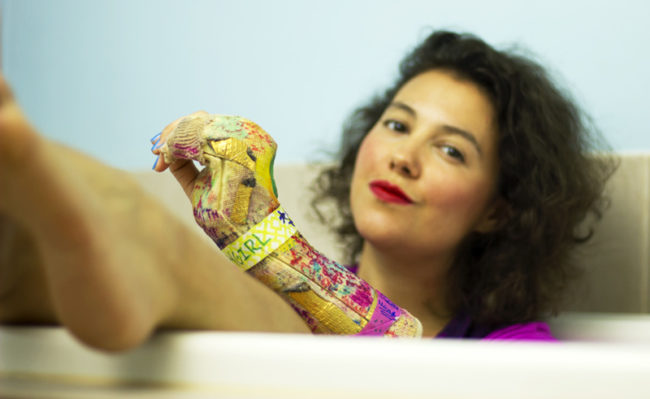
I’ve been very lucky that for the most part, actually almost entirely, everyone’s home that I have performed in has either been the home of friends or friends of friends. These end up being people who are cool, that I can trust, and where I feel safe. In this day and age, you just don’t know. But the social network is amazing, you can say “Who knows people in this city? I’m in Tokyo or I’m in Minneapolis and I want to do bubble baths, who do you know that would be up for that?” I’ve had an awesome experience that way. Meeting people who I will always remember because of these experiences has really touched my life.
Do you have one bath— or one city or place— that really stands out above the rest? Maybe a “that was the bath?”
Siobhan: That was the best? There’s been so many experiences that I really treasure. When I was in the Isle of Man, which is a random tiny island between England and Ireland, actually I went to art school with a Manx gentleman and he is a very dear creature in my life. His name is Robin Higgins. He got me out there. He told me he would get me some bathtub gigs and some teaching gigs. He’s an angel creature in my life and we had an awesome experience there. We performed at some of his friends’ place, they own a record company called Small Bear Records. The living room of their home is set up for concerts. They had a downstairs situation where people were performing. There were bands playing and people were listening to music, and then I was upstairs in the bathtub. People could switch out, they would be downstairs listening to these bands play and then they could come upstairs and watch the bath show. And Robbin was just so great at filtering me through. He’d get me out of the tub, put me in the robe, get me water, and say “Hey there are eight more people downstairs who want to see this? Are you ready to hop back in?” And I’d hop back in and off we’d go!
That was really wonderful because that is what I would like the home theatre experience to be. I want it to be this wonderful magical use of space where there’s music, there’s art, there’s performance, there’s people mingling. I would do these shows and go downstairs in my robe and I’d listen to music. It was really special. I think that’s one that I really value.
I know that the story itself that you tell in Broken Bone Bathtub is based on your real life events. But how does one wake up one morning and say “Hey I want to tell my story and I want to tell it in the bathtub. How do I get the bathtub on the road?”
Siobhan: I genuinely was borrowing baths from my friends all over New York, in Queens, Brooklyn, Manhattan, and the Bronx. I was taking the subway to take a bath. I was in my cast at Don’t Tell Mamma, which is the piano bar on restaurant row in Manhattan, with a very good friend of mine, Michael Dale, who is a critic for Broadway World. He’s awesome and he’s actually coming to Baltimore to see the show while it’s here. He and I were sitting talking, I was wearing my cast, and I had just come from a bath. He was totally amused by it. He said, “It’s like you’re on a bathtub tour, it’s so funny.” And I said, “What if I was on a bathtub tour?”
My friend Seth Lepore, who is a Massachusetts based artist, he’s done a few living room tours. And my friend Antonia Lassar, who is a New York-based artist, she’s also done living room tours. There’s a movement with theatre artists who are performing and doing house shows. It’s what Mozart used to do. You get paid to perform in someone’s home where either the host invites people and pays you, or people just come and pay admission. Houses are cool things and I had really admired and been interested in that type of performance. Seth had actually come to Brooklyn and performed in my living room. I loved it. I loved how much we changed the space. It was a loft space where the dining room and living room shared the same space. We moved the dining room table out and we loaded chairs in, there were ten seats. We had a little table that was positioned for him with my loft bed lamp that he carried down and plugged in. I was just amazed at how theatrical that little loft bed lamp was.
He sat in a chair and he clicked the lamp on. It felt like a beautiful, intimate, special performance space. He crawled over to the wall at one point and pulled a push-pin out of the wall and became a different character. But it was my living room! It was so beautiful. I was really inspired by what he had done at that show in that space. I always thought that I would love to do a living room show and that would be great. My current plays are not really written for a living room. When Michael said “it’s like you’re on bathtub tour” I thought about whether or not I could actually do that. I went through my journals. I keep a journal kind of consistently, or at least I try to. I started looking at the things I had written over the course of my injury, wondering if I had written anything of merit or value or useful. I started picking things out and going through the arduous process and speaking the writing into my phone and manually editing all the typos with only one hand. Because I only had one hand.
And from that you created what you now deliver in Broken Bone Bathtub?
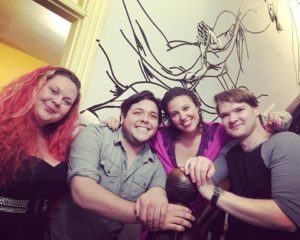
Siobhan: I compiled my writing into 30 minutes’ worth of performance text. It went through three or four different drafts but then I had a 30-minute script. Originally it was just intended to be this 30-minute monologue, the audience comes in, I do my monologue, they leave. Within 75 minutes I could squeeze in two shows. I figured it would be this really fast-going thing but that’s not at all what the thing became once I had it in performance. I hadn’t planned for all of the interaction. The physical washing stuff, with my body and my hair, that was there. But I hadn’t planned on having a dialogue with the audience, it just sort of happened. And as that process went on I realized “this is what this play is meant to be.” It’s not a monologue in a bath, it’s a dialogue between friends.
This is what actually happened. My friends would help me in the bath, I would tell them what had happened to me. I talked to them. When you’re talking to your friends you tell them your experiences, you ask them if they can understand you or if they can relate to you. And they share their experiences with you and that helps you feel better. That, naturally, is what the performance came to be. It became a very literal recreation of this experience I had with my friends. My friends were amazing generous people who bought me new bubble bath, who washed their best bathrobes for me, who ordered me dinner, and bought me chocolate and wine. There were just so many different ways in which my friends came through for me during this difficult time and to me they really embody what New York is to me.
You said you might try and round out 2016 with 195 baths, but how long have you been at the bathtub process?
Siobhan: A year and a half. I had my accident in October of 2014. The script finally came to reality in February of 2015. It went on stage in Tokyo as a world premiere in April of 2015. I had no idea what I was doing! I was in the bubble bath waiting for people to come up and all that was racing through my mind was “Shit, my younger brother just landed on a TV series, and my older brother just got his PhD. And I’m naked in a bath in Japan. What am I doing?” It kind of happened pretty quickly from accident in October to production in April.
When you first started performing were you still in your cast?
Siobhan: I was out of the cast. The bones are actually not healed. My hand is pretty arthritic, actually. I can’t play an instrument so well. I can type. I can do a push-up.
You’ve been all over the world. How did you end up back in Baltimore or rather how did you fall in league with Submersive Productions?
Siobhan: I did Baltimore premiere of this at Charm City Fringe last November. Zach and Mike (Charm City Fringe Co-Founders Zachary Michel and Michael Brush) are just wonderful, I love them. That sold out quite quickly, we had a six-seater, I did eight-shows and that was that. I also had a good friend base here who were very excited about coming out to see my new work! When I performed in LA I was on this thing called “No Proscenium.” It’s this immersive theatre mailing list and podcast thing. They’re all about immersive theatre and theatre that does not happen on a stage. I tweeted at them about Bathtub and they listed me. I got tons of audience from their list. And they came to see me. The guy who runs it, Noah Nelson, if I ever see him again I owe him tons of drinks. He really, really supported me. I think for a while I was on his Top-Five Favorite Lists.
Glenn and Ursula (Submersive Productions Co-Founder Ursula Marcum) heard him talk about Broken Bone Bathtub on No Proscenium, the podcast, and they reached out. I think once they’d heard him talking about it and then saw that I got a mention in the New York Times— because they were doing a write-up on immersive theatre— they decided they wanted to get in touch. They emailed me and said, “Hey, we have a bathtub, we have a cool company, we know people who know you, we just did this show that had people who know you in it,” and then that was that. They have just been so great. They asked me what it would look like, they asked me for my terms. I emailed them with some basic terms and they were just like “Great, when do we do this?” And August was the next time I could and it all just came together.
This is a nice thing for a company to pick up on because it’s just such a doable show. I mean there are things involved, all that press work and Glenn and I are working on the ticket site all the time. And it’s a bigger challenge with sending the reminder emails and all, but the show itself is just great. I don’t have to hire a cast, and they don’t have to think about huge budgets either. I was super excited to hear from them and I’m so glad that this has just been such a fruitful endeavor and such a well-matched fit. It’s amazing how well we fit together, I’m really going to miss them.
Is the installment art that is featured here in the Baltimore production something you coordinated?
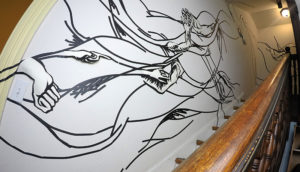
Siobhan: That’s them! They said “we want to do something really specific for you, we want this to be a totally immersive experience for you.” And I just said go for it. Live your dreams, I’m down with that. So far I’ve been very open to taking people’s ideas, sometimes they work— like in Australia at the You Are Here Festival we had a huge backyard with a hot tub and I performed for 40 people. And that was awesome. And it worked. Outdoor hot tub? Awesome. Hotel room in Orlando? Mansion in St. Louis? Not so awesome. But you have to try something to learn about it. This with the installment art piece? It’s been totally awesome. They’ve had Amanda (installment artist Amanda Burnham) craft this piece just for my show and it’s great! Arriving at a house where there is a giant art installation based on your text? It’s like Christmas morning! What a total gift and what an absolute delight that has been.
What does it mean to you now to just take a bath? You do it as a performance, and it’s a very important element of your performative and narrative history, but what is it like for you to take a bath at home alone?
Siobhan: The thing about me is that I’m kind of a hippie. I hate showers. I just hate them. I hate taking showers. I find it to be work. I just don’t have time; I can’t be bothered if I have to choose between having breakfast or a shower I’m going to have breakfast. In growing up, even in high school, I always preferred the bath. I would rather wake up early and take a bath. I wonder what kind of person that makes me. I guess it makes me a bathtub kind of girl. But in Brooklyn I did not have a bath. I lived in a loft warehouse. And it is a bummer. It means when you are visiting somewhere that does have a bath, you treat it like a real luxury.
Now that I’m a nomad with no fixed address and because I perform so much it’s rare that I bathe alone at all. I’m taking five baths a week. I sweat because I run, I love to run. But I do cooling down exercises and I’ll do a quick hose down with a little toweling off, but I don’t want to spend the time taking time to clean off. I certainly don’t need to wash my hair. It gets washed five times a week! Other people wash my hair now. There have been times, like when I was house sitting for a friend of a friend in New York, it was winter and really cold and horrible outside. There are times like that where you really want a warm bath. But I’ve discovered now that taking a bath alone feels very secretive and super private. I can sit anyway I want! I don’t have to cover myself or worry if I’m exposing myself. Not that I worry deeply about that in the performance but I do try to preserve modesty. Bathing now feels like this really special thing.
I don’t like showering with a partner or a romantic interest. I feel like I need to get this done and I need to get that done, and can’t we just shower separately and do our thing? Having been performing in the bathtub for so many baths now, I feel like taking a bath with a romantic interest now— with just one person— would be really exiting now because I can share this experience with them and I don’t have to be modest. It would be more intimate than ever because of how intimate the bath is for me now with strangers.
What has taking yourself on this bathtub tour taught you about yourself?
Siobhan: Something that a lot of people say to me is “you must be so confident, you’re in the bathtub, you’re naked and you just don’t care.” My response is I’m really, really not. We were just talking about how I need to lose ten pounds to look a particular way. Glenn (Submersive Productions Co-Founder Glenn Ricci) took all these pictures of me for this run and I was looking through them and just hating them. And he said, “Look, these are not pictures of you. These are pictures of a certain perception of how the camera sees you. This is not how people see you.” Bless him, he was so patient with me as I sat there not liking most of them. It’s still something that I really struggle with, this physical confidence and self-esteem.
In Hollywood, the bath totally drained. I was in this extremely old beautiful antique type tub and it just totally drained. Slowly. I realized halfway through what was happening and I told the audience, “this is what’s happening.” They were so supportive. Some of them started taking their shirts off. It taught me that people aren’t going to run away if they see me. I’m not gross or repulsive. When you look at someone else, I think that most of us as long as we have a little bit of kindness in ourselves, most of us do not look at others and immediately seek out physical judgement. We see the person. We look at their face, we look in their eyes. But we never seem to see that in ourselves. We see ourselves through all these other horribly judgmental and unkind lenses. Doing this bathtub show is a reminder to look at myself the way I look at others. People are here at the bathtub show to hear me and to see me— not to see me in the “oh what does she look like, is she fat or not, is she ugly, is she gross”— but to see my story. They’re looking to see who this person is not what I look like.
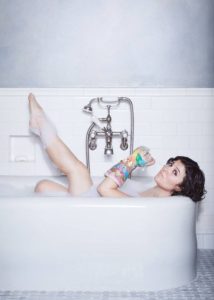
The other thing that I have learned, but I knew this before because a lot of my theatre is based on interviews and docu-drama, people really deserve to be asked questions about themselves, their lives, and their truths. We don’t get that often. I did a show in Brighton, England and it was one of my favorite shows. My friend, Hot Scottish Ben, who lives there— he is amazing, he is hot and Scottish, and his name is Ben. I absolutely love him. He’s a total luxury to be around. We did shows at his house. He wanted me to do this show for his friends and his housemates. He told me they probably weren’t going to like it because they were a bunch of dudes, but he wanted me to do it anyway. The show was amazing. It was this group of lad’s lads who were completely uncertain about what they were going to see, but who ended up getting completely invested. They bonded with each other, they told stories that were hilarious, they talked openly about their sadness and their tears and the ways in which they hadn’t been there for each other and their regrets. Afterwards one of them said to me, “I never thought that my stories were interesting. I didn’t think that people would care. That’s why I don’t talk a lot. I didn’t think that people would want to know.”
I feel like this show is a constant reminder that people have stories and they want their stories to be told. You’ll notice in the show that’s why I push a little bit with the audience. If someone gives me a short answer, I’ll nudge them a little bit. I engage with them and coax it out. I think people want to be coaxed, they want to talk. But we have to ask them. It actually makes dating a little hard. I have a romantic interest right now who says to me all the time, “Siobhan, is that a leading question you’re asking me?” I’m apparently really good at leading questions. But we don’t get asked enough about our lives as people. Doing the bath has helped me realize just how close strangers can become to one another when they’re given a space in which to be real.
There was a person here in Baltimore who asked me one night after one of the shows, “Is there an answer that you’re searching for? Is there a specific thing you’re after when you ask these questions? Is there something that you’re getting at when you’re asking these questions?” There really isn’t. The only thing I’m seeking for in these questions is sincerity. When we’re in a time of need, we’re at our most vulnerable place and we want people to be real with us. Someone leveling with that vulnerability is so healing and really contributes to the process of getting better. Getting better can mean a lot of things, it can be getting better from a physical injury or from an emotional injury. It can be surviving a deep level of trauma— and I don’t claim that my trauma is deep in this circumstance— but it helps me get to people who are going through something that is deeper. This thing that hurt me and made me feel alone might also connect to you for something much greater that made you feel alone. The ways in which we feel alone can help us to find the ways in which we don’t.
What do you hope people will take away from attending Broken Bone Bathtub?
Siobhan: I hope that they have a renewed sense of community when they leave. I hope that their minds are open to what community can be, on where it can stem from. I hope that it encourages them to seek out community in unlikely places and from unlikely people. I hope that they are reminded that their stories are interesting and valuable. I hope that they consider the ways in which they may or may not have healed from their various life injuries and struggles. I hope they can consider how that healing might continue. I hope that they are also reminded of the power of each other, the power of other people, the power of strangers. Someone can be sitting next to you and they are very interesting, you just never knew it. If they’re young, I hope they’re like “oh, cool! This is a performance! This is a performance space!” Maybe they’re old and they’re thinking that too. I hope that their framework of what performance can be is broadened. Those are my main objectives.
Anything else you’d like to say about the experience?
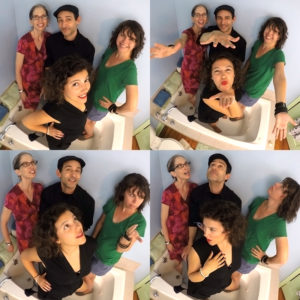
Siobhan: Again I really just want to say that Glenn and Ursula have gone just above and beyond anything I ever could have expected. Anything that I’ve asked for, anything that I’ve needed, I don’t have to remind them, they do it. I’m really very happy and proud of their work, and their compassion for the content of the work, and their care for me. The way that they’ve treated me has just been really wonderful and I hope they feel that way about me too. They’ve just been so awesome. It’s also just really great to be back in Baltimore, walking around Fells Point and reconnecting with all these people that I love. I just feel really happy. I was on the phone with my romantic interest, he is back in New York, and he said “Wow you just sound really happy.” I’ve been on the phone from other cities and have sounded less than thrilled. And other cities have been very stressful. Baltimore has just been truly amazing!
Broken Bone Bathtub: Submersive Edition plays through September 11, 2016 in a historic rowhome in Baltimore City near Patterson Park. The location will be disclosed once tickets have been purchased. Tickets may be purchased here.
For more information regarding upcoming Submersive Productions, click here.
To read the review of Broken Bone Bathtub, click here.

